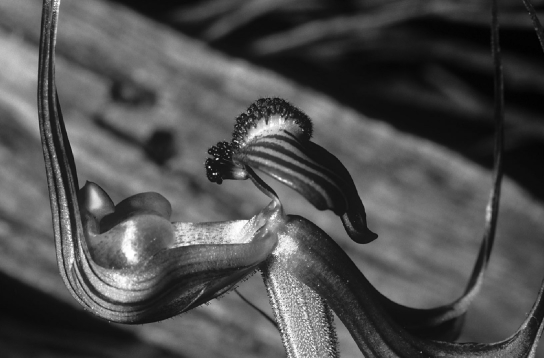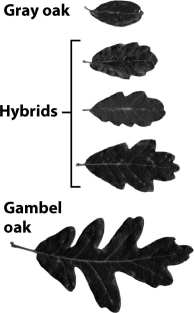Correct Answer

verified
Correct Answer
verified
Multiple Choice
Populations of weaver ants work together to "sew" leaves into a living nest that acts as a protective shelter for the entire population. The nest-building behavior of weaver ants
A) illustrates that the ants can consciously plan their nests.
B) represents a complex behavioral adaptation.
C) shows that these ants can get along without interacting with other species.
D) illustrates that adaptive evolution is goal oriented.
F) A) and C)
Correct Answer

verified
Correct Answer
verified
Short Answer
____________________ barriers cause speciation to occur by preventing fertilization when two individuals of different populations attempt to mate.
Correct Answer

verified
Correct Answer
verified
Multiple Choice
The formation of a new species
A) can occur slowly or rapidly.
B) takes at least 1 million years.
C) is evolutionarily insignificant.
D) never happens.
F) B) and C)
Correct Answer

verified
Correct Answer
verified
Multiple Choice
Before the cultivation of the apple tree, apple maggot flies laid their eggs exclusively on the fruit of Hawthorne trees. As apple orchards became more prominent, apple maggot flies began to lay their eggs on both the fruit of the Hawthorne tree and the fruit of cultivated apple trees. Now, apple maggot flies that live on apple trees mate and lay their eggs at different times of the year than apple maggot flies that live on Hawthorne trees. Is this an example of reproductive isolation?
A) Yes; these two fly populations exhibit a postzygotic barrier that prevents hybrid individuals from developing properly.
B) No; although these two fly populations do not mate in nature, they can be forced to mate in a laboratory because their DNA sequences are still the same.
C) No; this is an example of speciation rather than reproductive isolation.
D) Yes; these two fly populations exhibit a behavioral prezygotic barrier that prevents their gametes from encountering each other.
F) C) and D)
Correct Answer

verified
Correct Answer
verified
True/False
Sympatric speciation can occur in the absence of geographic isolation.
B) False
Correct Answer

verified
Correct Answer
verified
Multiple Choice
The primary difference between the prezygotic barriers and postzygotic barriers involved in reproductive isolation is that prezygotic barriers
A) are related to gametes and postzygotic barriers are related to gametes and to behaviors after birth.
B) occur in species that undergo only asexual reproduction, whereas postzygotic barriers occur in species that undergo sexual reproduction.
C) occur in species undergoing allopatric speciation, whereas postzygotic barriers occur in species undergoing sympatric speciation.
D) prevent fertilization from occurring, whereas postzygotic barriers prevent offspring from developing or being reproductively successful.
F) B) and C)
Correct Answer

verified
Correct Answer
verified
Multiple Choice
Polyploidy can lead to
A) a high rate of gene flow between populations.
B) geographic isolation.
C) fewer chromosomes.
D) reproductive isolation.
F) B) and C)
Correct Answer

verified
Correct Answer
verified
Multiple Choice
Which of the following does not provide an example of geographic isolation?
A) Two populations live in two valleys on opposite sides of a mountain range.
B) Two populations live on different mountains with a valley between them.
C) Two populations live on opposite sides of a river.
D) Two populations live in different parts of a small lake.
F) C) and D)
Correct Answer

verified
Correct Answer
verified
Short Answer
A ____________________ species may exist when an organism's range loops around a geographic barrier. Neighboring populations in the range mate, but populations on opposite sides of the barrier cannot mate.
Correct Answer

verified
Correct Answer
verified
True/False
Evidence suggests that Neandertals and humans are the same species.
B) False
Correct Answer

verified
Correct Answer
verified
Multiple Choice
For two populations to accumulate enough genetic differences to cause speciation, the factors that promote these differences
A) must operate in populations that are not physically separated.
B) must have a greater effect than does the amount of ongoing gene flow.
C) need to be combined with the forces of genetic drift.
D) should include polyploidy.
F) C) and D)
Correct Answer

verified
Correct Answer
verified
True/False
The observation that the flowers of this orchid resemble female wasps is an example of a complex adaptation.

B) False
Correct Answer

verified
Correct Answer
verified
Multiple Choice
In many predator-prey relationships, evolutionary change in the prey will result in evolutionary change in the predator, a phenomenon known as
A) polyploidy.
B) allopatrism.
C) coevolution.
D) sympatric speciation.
F) A) and C)
Correct Answer

verified
Correct Answer
verified
Multiple Choice
Polyploidy can lead to very rapid speciation in plants because
A) polyploidy increases the amount of gene flow between polyploid plants and nonpolyploid plants.
B) the DNA sequences of essential genes are altered to such a degree that the polyploid plant can no longer mate with the original species.
C) the gametes of polyploid plants have too many chromosomes and cannot fuse to the gametes of the original species.
D) when a plant becomes polyploid, it often loses the ability to make gametes of any type.
F) A) and C)
Correct Answer

verified
Correct Answer
verified
Multiple Choice
Some species of orchids attract wasps to assist them in reproduction by producing flowers that look like female wasps. The flowers fool male wasps into attempting to mate with them. As a result, the wasp is covered with pollen that it takes with it to the next flower it attempts to mate with. This example shows adaptive evolution by
A) the orchids.
B) the wasps.
C) all flowering plants.
D) ancestral wasps.
F) A) and C)
Correct Answer

verified
Correct Answer
verified
Short Answer
____________________ speciation occurs when a new species arises in the absence of geographic isolation.
Correct Answer

verified
Correct Answer
verified
Multiple Choice
Every year, environmental signals in Africa cause flycatchers to return to the Netherlands to breed. When they arrive, they depend on freshly hatched caterpillars for food. Global climate change has caused the caterpillars to hatch earlier in the Netherlands, but the environmental cues in Africa remain the same. Now, when the flycatchers return to the Netherlands the caterpillars are no longer available as a food source. Which of the following is likely to happen to this species of flycatcher?
A) Flycatchers will adapt to environmental change because alleles that cause flycatchers to recognize earlier environmental signals in Africa will increase in frequency in flycatcher populations.
B) Flycatchers will adapt to environmental change because alleles that aid flycatchers in utilizing other food sources (besides caterpillars) will increase in frequency in flycatcher populations.
C) Flycatchers will not adapt to environmental change because their population does not have alleles that aid in survival under these conditions.
D) All of the above are possible scenarios.
F) A) and D)
Correct Answer

verified
Correct Answer
verified
True/False
Some species, like the gray oak and the Gambel oak, hybridize to create fertile offspring, but remain phenotypically distinct as shown by the leaves in the image below. As a result, they are considered different species.

B) False
Correct Answer

verified
Correct Answer
verified
Short Answer
Speciation can occur when populations of a species are separated by a physical barrier becoming ____________________ isolated and subsequently reproductively isolated from one another.
Correct Answer

verified
Correct Answer
verified
Showing 41 - 60 of 80
Related Exams